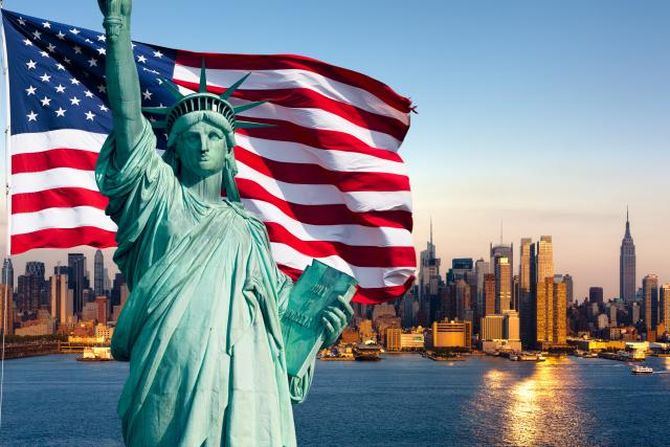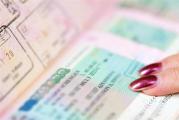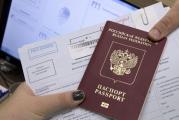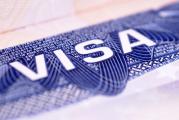Visa to the United States of America
Applying for a US visa on your own. Visa centers of the United States of America, which visa is needed, how much it costs and how to apply. Visa-free entry or documents for obtaining a tourist visa.
It’s time to write sagas about the intricacies of obtaining a visa to the United States of America: everything here came together - both the unreasonable nitpicking of consular workers even about the most “strong” packages of documents, and the unexpected ease in obtaining the coveted stamp in the passport for the most emigrant-minded tourists. A feature of applying for an American visa is the absence of a single list of documents, according to the principle “bring everything, and then we’ll figure it out.” In general, the goal of the tourist is to convince the consulate that he cannot imagine life without the Motherland, and no benefits of capitalism will undermine this filial love. Phantom bonus - multiple entry visa for a year by default and the possibility of obtaining a 3-year "cartoon".
A visa to the United States is always required, even if you are flying with a transfer and are not going to get off the plane. The package of documents for a transit visa is no less than for a regular tourist visa.
Those who are going to visit the States in the near future should take into account that the issuance of visas is limited (as of 2018).
Tourist visa to the United States of America
general information
The cost of a regular visa
Express Visa
Visa fees
Types of visas
US visas can be divided into two categories: non-immigrant for temporary stay and immigrant for permanent residence. In the first - a lot of subcategories and nuances with the design, in the second - its own strict rules and requirements. There are the following types of non-immigrant visas:
- for business and leisure trips B1/B2;
- working H, L, O, P, Q, R;
- student M, F;
- transit and for crew members C1/D;
- for participants of exchange programs J;
- for housekeeping staff A3, G5, B1;
- for media workers and journalists I.
Business and travel
The B1 visa is for business travellers, the B2 visa is for tourists and those seeking medical care. In practice, combined B1 / B2 are more often issued, single and multiple for up to 3 years.
Of fundamental importance for the consul are not only documents, but also the answers of the applicant at the interview.
An approximate formula for success is confidence and clarity of testimony, healthy patriotism, plus a hefty package of papers confirming ties with the homeland, previous travel experience and the purpose of the upcoming trip (from income and property statements to business correspondence related to the program).
Previous photo 1/ 1 Next photo
workers
You can work in the US without immigrant status by issuing one of the non-immigrant visas for a maximum period of 2 years: H1 for highly qualified professionals, L for those who are temporarily transferred to US units, P for representatives of the entertainment industry and athletes, Q for participants in international cultural exchange programs , R for religious figures and O for those with extraordinary abilities. In the list of documents - a petition in the form I-129, approved by the Citizenship and Immigration Services prior to application. Proof of qualifications will not be superfluous: resumes, diplomas, letters of recommendation, etc.
Student
The F visa is issued to students enrolled in private schools, colleges and universities in the United States, as well as those who are going to learn English as part of various programs. The M visa is intended for persons entering the country for the purpose of non-academic or vocational training, and for those who plan to combine tourism with studies on a reduced program (less than 18 hours per week), a B2 visa is sufficient. At the interview, you need to have an approved Form I-20 from a graduate school and proof of payment of SEVIS - a student fee in the amount of 180-200 USD. The maximum term of a student visa is 1 year. Prices on the page are for August 2018.
Previous photo 1/ 1 Next photo

Transit and crew
Visa C is required for travelers traveling through the United States to other countries, D - for crew members of ships or aircraft served in the territory of the States. The consul needs to provide tickets and visas of the countries of destination or documents confirming work on the ship. The maximum term is 2 years.
For exchange program participants
Specialists in the field of culture, science and education - students, interns, school and university teachers, researchers and participants in the Russian-American partnership programs - apply for a J visa for up to 3 years. To do this, you must provide the approved form DS-2019 and standard documents: old passports, certificates of property and income, correspondence about the exchange program, etc.
If the program is sponsored by the US government (indicated by the initial letter G in its number), you do not need to pay an application fee. Otherwise, an I-901 SEVIS fee is also required.
For home caregivers
Butlers, chauffeurs, maids, cooks and nannies receive visas depending on who their future employer is: a diplomat with an A1 / A2 visa - an A3 visa is required, an employee of an international organization with a G visa - a G5 visa is required, a US citizen or nonimmigrant visa holder - B1 . The list of required documents includes a copy of the employer's passport or visa, as well as a contract drawn up in accordance with all the rules and its signed copy. The maximum term is 3 years.
Applicants A3 and G5 are exempt from the fee, for B1 you need to pay the standard 160 USD.
For media workers and journalists
The I visa is issued to foreign reporters, editors, film crews entering the United States for professional purposes, but B1 is enough for photographers who do not receive payment for their activities in the country. The employer must provide a letter stating the name, position, purpose and duration of the trip.
Visas are issued mainly single-entry, for 3 months, but for long business trips - multiple annual ones.
Immigrant visas
Applying for an immigrant visa is an application to stay in the US and subsequently obtain citizenship. Typically, the process is initiated by a family member, a citizen or permanent resident of the United States, or an employer who plans to hire an immigrant for one of the permitted positions. They are the ones who file the I-130 petition with the Citizenship and Immigration Services. The applicant will have to pass a medical examination and a standard interview. The USCIS immigrant fee is $220.
US visa documents
American laws do not define an official list of documents required to obtain a visa, so it is very important to provide the consulate with the most complete package of documentation confirming a strong financial position, as well as family and business ties.
The main documents required for obtaining a visa:
- international passport with at least one blank page, valid for at least 6 months after the end of the trip;
- an old international passport (or its copy), if it had visas from the USA, Canada, Great Britain or Schengen countries for the last 5 years;
- photo 5x5 cm, photo requirements see below (photos must be provided by all applicants, including children entered in the parents' passport);
- filled in at online questionnaire in English in the form DS-160 (men aged 16 to 45 years also need to complete the application in the form DS-157). The DS-160 Application Confirmation Page must be printed on a laser printer: it contains information about the applicant encrypted in an individual barcode that must be legible. If the code is not clearly printed, there will be a problem with finding and identifying information, which will lead to the need to re-register for an interview and submit documents;
- receipt of payment of the consular fee;
- evidence that the tourist will leave the United States at the end of the stay.
Documents can be drawn up in both English and Russian.
As evidence that the tourist will leave the United States at the end of the trip, it is recommended to submit the following documents:
- a certificate from the place of work, including information on income (in some cases, information on the income of the spouse or parents, as well as other documents confirming the presence of a permanent income in the Russian Federation) or a certificate from the place of study (for students) may be required. For owners of IP / PBOYuL - copies of the certificate of registration and certificate of tax registration of the enterprise. For the unemployed or retired - a statement of sponsorship of the trip from close relatives, copies of documents confirming kinship, certificate of employment of sponsors and (or) any other documents confirming the ability to pay for the trip;
- information about the presence of next of kin in the Russian Federation (husband/wife, children);
- documents confirming the presence of property in the territory of the Russian Federation;
- information about the goals and objectives of the trip (tourist voucher, hotel reservation);
- an old passport with a previous visa and a stamp indicating the date of return to Russia (for persons who have already entered the United States before).
Do not forget to take out medical insurance for the entire duration of the trip. Although the policy is not asked when entering the country, it is at least unreasonable to travel without it.
For minors, a copy of the birth certificate must be provided. If children travel to the United States without parents or with one parent, you must provide a notarized permission from both or from one parent, respectively.
It is better to collect documents with some excess: the more all kinds of certificates confirming the adequate level of income of travelers and their blood attachment to the Motherland, the better.
In some cases, consular officers can check the applicant's visa account on social networks.
Visa processing for children
Children under 14 do not need to be interviewed, but the process depends on whether the parent has a valid US visa. If available, documents can be submitted via Pony Express: pay the consular fee, fill out the DS-160 form in the name of the child, create an account on the embassy website, carefully answer the questions in section 7, receive a letter confirming the submission of the application without an interview, print it and bring it to the office. You must have a passport and a photo of the child, a photocopy of the parent's visa, documents for a visa of the required category and their inventory.
Teenagers over the age of 14 must be accompanied by their parents during the interview.
If the parent does not have a visa and he signs up for an interview, the child should be listed as a dependent family member. But you do not need to bring him to the consul: it is enough to provide his passport and a printed page confirming the interview.
Photo Requirements
First rule: The photo must be taken within 6 months prior to the application. If the previous visa has expired and a new one is needed, you will have to take pictures again. The facial expression is neutral, the gaze is directed directly at the camera. The head should fit completely into the frame and occupy 50-70% of the image area.
The photograph itself is square, 5x5 cm in size, with a resolution of 600x600 to 1200x1200 pixels. Background - white or close to white. Casual clothing: no uniform, headgear (except for those worn for religious reasons, and even then not hiding the face), headphones and glasses. People who wear hearing aids or similar devices at all times are allowed to take pictures with them.
US visa fingerprinting
Since 2003, the US Embassy in Moscow has been scanning the fingerprints of all applicants between the ages of 14 and 79. Usually during the interview: digitally without the use of ink. For applicants who do not need an interview, a visit to the embassy or consulate is scheduled for a fingerprint procedure. In order to freely enter the territory, the applicant must present an invoice from Pony Express and a valid civil passport.
If the applicant has cuts, calluses or other temporary injuries to the fingertips, they will have to reschedule the date of the procedure and report to the embassy when everything has healed.
However, since November 2008, there have been some indulgences regarding the general scanning of "fingers". Applicants who have already undergone the 10-fingerprinting process at the U.S. Embassy or Consulates General in Russia may be exempted from interview and fingerprinting upon subsequent visa application, subject to the following conditions:
- re-application is made no later than 11 months from the date of expiration of the previous visa;
- the applicant is applying for a visa of the same category as the expired visa;
- there is no Clearance Received mark on the previous visa;
- the visa application takes place in the applicant's country of permanent residence and complies with the requirements of United States immigration law.
Consular fee
The consular fee for all non-immigrant visas, except for workers, is 160 USD. Applicants for work visas will have to fork out 190 USD. The fee is paid in ruble equivalent before submitting documents to the consulate at the offices of the Russian Post or using a bank card. Charged in full from each applicant, including children entered in the parents' passport. In the event of a successful transaction, a receipt will be sent to the email address provided by the payer containing the identification code required to make an appointment for an interview at the consulate.
Filling out a visa application
The electronic application form DS-160 is filled in English directly at the office. US Embassy website. Such an application contains all the data entered by the applicant, this information will be encrypted in a barcode.
If there is no user activity, the form filling session will time out after 20 minutes. To avoid data loss, it is worth saving the file with the application to your computer more often. When submitting to the site, you need to upload not only the DS-160, but also a photo that meets all the requirements. After filling out the form, a page with a barcode will be generated, which must be printed and brought to the interview with the rest of the documents.
Application procedure
After paying the consular fee (no earlier than 2 business days) and filling out an electronic application form DS-160, you must sign up for an interview on the embassy website. For registration, you must specify the numbers of the international passport, the document confirming the payment of the consular fee and the 10-character barcode from the DS-160 submission confirmation page.
Passports with a visa are delivered to the address indicated at the time of registration or stored until required by Pony Express, the cost of its services is included in the consular fee. You can track the status online and by calling the call center. To obtain a passport, the original of any identification document and a printed letter with an invitation to an interview are required.
Visa processing time
As of July 2018, the waiting time for an interview for applicants for tourist visas in Moscow and Yekaterinburg is 300 calendar days, in Vladivostok - 50 days. For student visas in Moscow they invite you after 2 calendar days, in Yekaterinburg - after 60 days, in Vladivostok - after a day. If the conversation with the consul goes well, the documents will be processed fairly quickly: from 3 working days. If you do not need to pass an interview (for example, upon re-entry), a visa is issued in 7-30 days.
A valid American visa may be in an already expired passport: at the border you will need to show both the old passport with a visa and a new, valid one.
Visas to the USA in 2018
Now only the Moscow embassy and consulates in Yekaterinburg and Vladivostok work in Russia. The queues for an interview are gigantic: in order to get to the consul in the capital, a tourist needs to wait almost a year or hope for a miracle. So for those who apply for a visa for the first time, it is better to think about a trip to neighboring countries - Latvia, Georgia or Lithuania. Holders of visas that expired less than 11 months ago can expect to receive a new one within a month.
The most common type of visas issued are "cartoons" for up to 3 years for tourism, business and study purposes.
According to statistics, every 10th Russian is denied an American visa. At risk are young, single and childless boys and girls with modest salaries, applicants for student visas who do not speak English, residents of the Stavropol, Krasnodar Territories, Dagestan and areas close to "hot spots". Also in doubt are persons who previously violated the deadlines for returning from the States, were denied a visa, or are traveling to relatives who immigrated from Russia to the United States. The absence of Schengen visas and the discrepancy between personal data and answers at the interview will also alert the consul. And if a forgery of documents is discovered, you will never see permission to enter.




